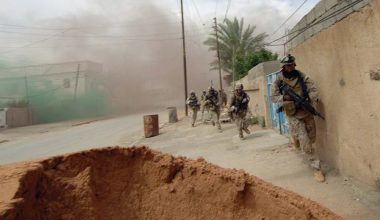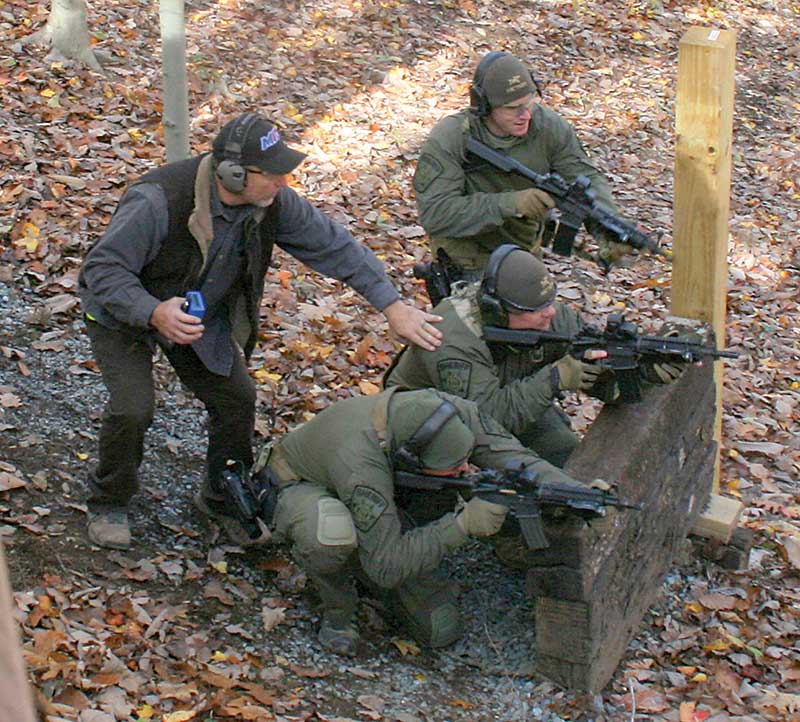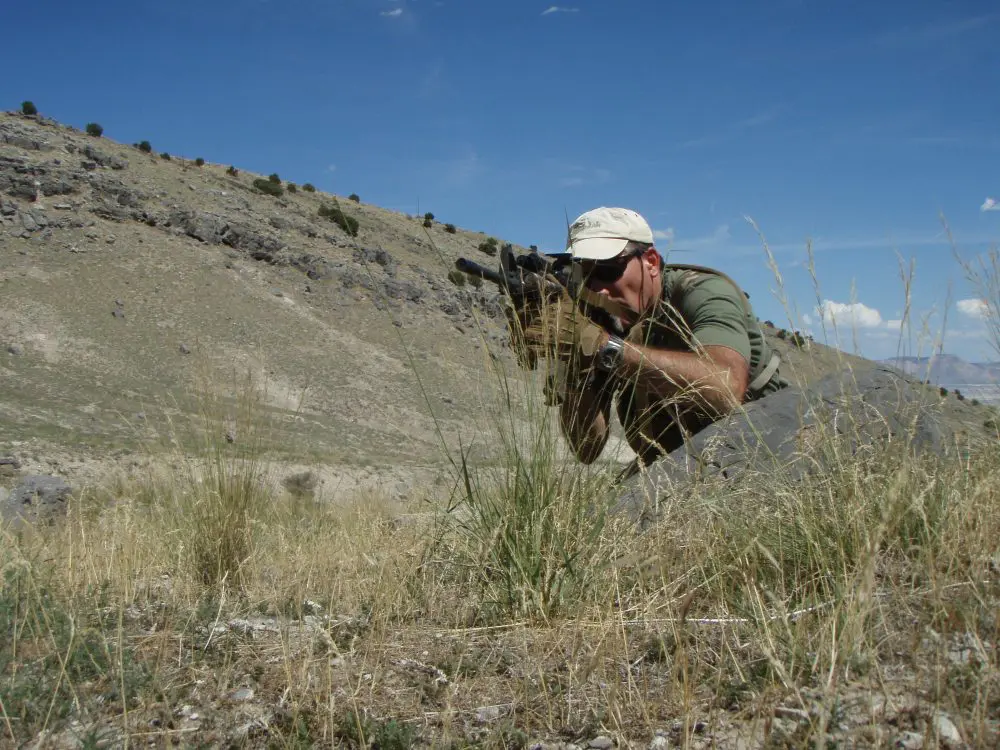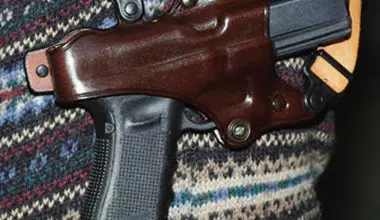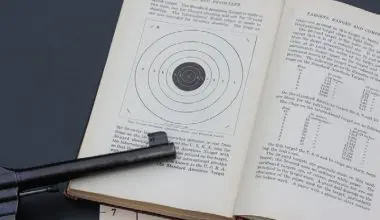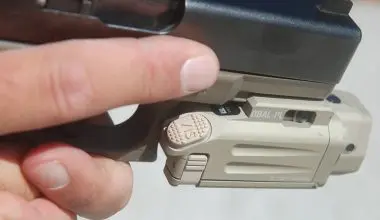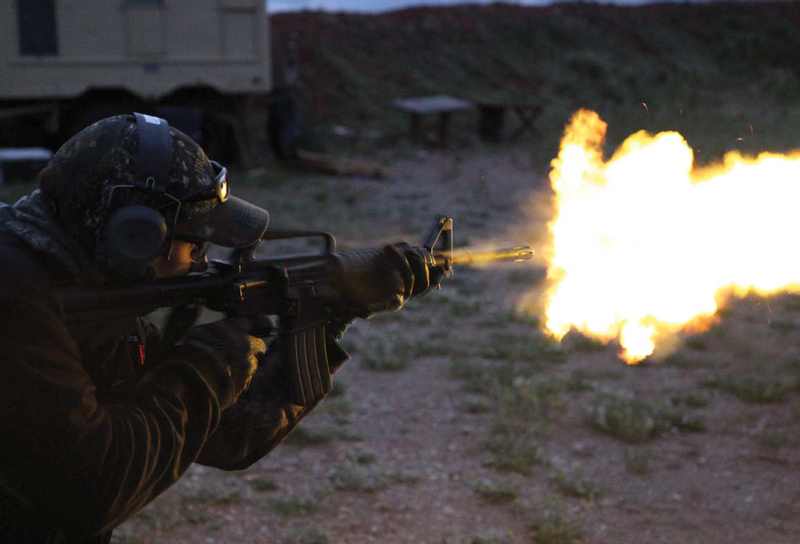
He’s a large man with a voice that carries and a demeanor that encourages listening. As well it should be, since Farnam, a decorated Marine Corps Infantry officer and law enforcement officer, has been conducting defensive training for 40 years. Along with John’s wife Vicki and a cadre of dedicated professionals, DTI presents real-world training.
Whether to a student at a DTI course or a young Marine at Quantico, Farnam teaches how it is, not how we want it to be. I recently attended Defensive Handgun/Urban Rifle, part of DTI’s curriculum.
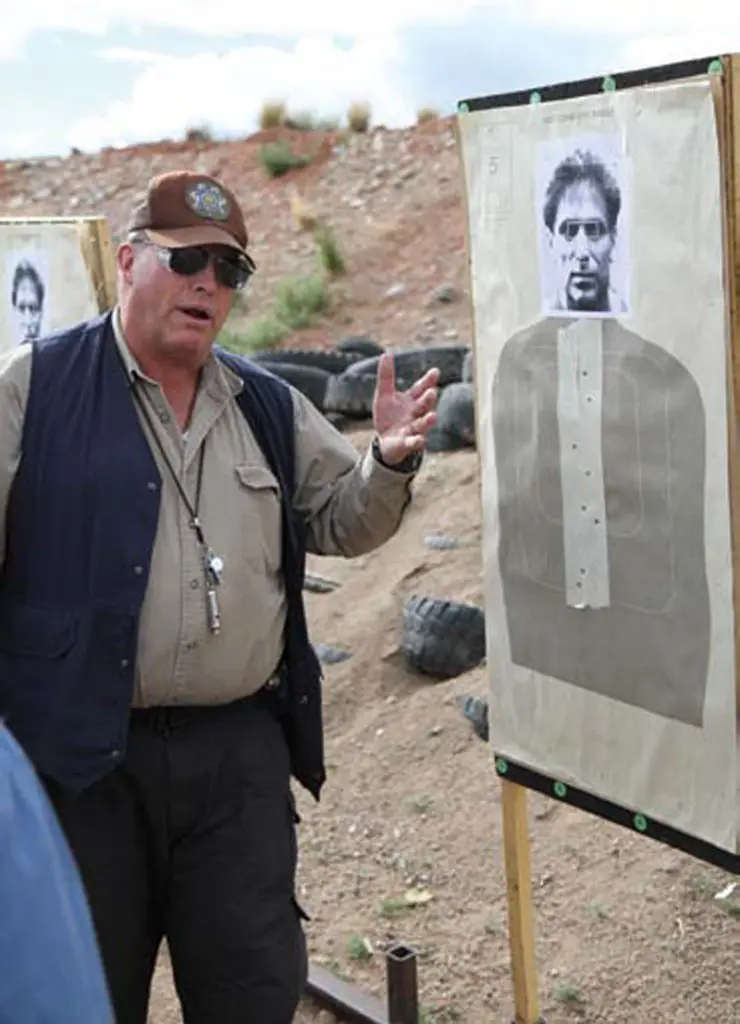
Table of Contents
LEAVE OFF THE BELLS AND WHISTLES
Not surprisingly, the weapons for this class were a handgun and a rifle. Virtually any type of these weapons was acceptable, but fully loaded versions were destined for failure and embarrassment. Farnam favors what he calls a utility gun, meaning a gun intended for serious purposes and designed to be operated in extreme circumstances.
During this class, I carried with great confidence a SIG P-250 Compact in .40 S&W in a Blackhawk Serpa holster. For the rifle, I chose a Del Ton 16-inch midlength with a flattop upper, Magpul stock and pistol grip with new Apex Machine forearm with GatorGrip. Both firearms ran without fault throughout the course.
The Farnams made the very most of the classroom time. Right up front Farnam outlined the goals of the class: be victorious and stay out of prison.
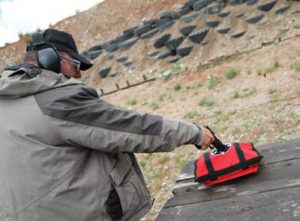
Fortune smiled on the students in this course. Because so many staff instructors were available, the student/instructor ratio was one to one. John noted, however, that the typical ratio is five to one. Students received more personalized attention than some had perhaps wanted. In addition to running the line and mentoring students, the staff instructors participated in the training at both the student level and as in-service training. Farnam himself even participated in the drills and challenges.
When I had sighted in my pistol before class, I’d shot very small groups, but two inches low. When I mentioned this to Vicki, she shot the pistol and found that it was properly sighted in. It appeared that I was doing something wrong, but very consistently. Vicki pointed out that for an experienced shooter, someone watching you is one benefit of taking a class.
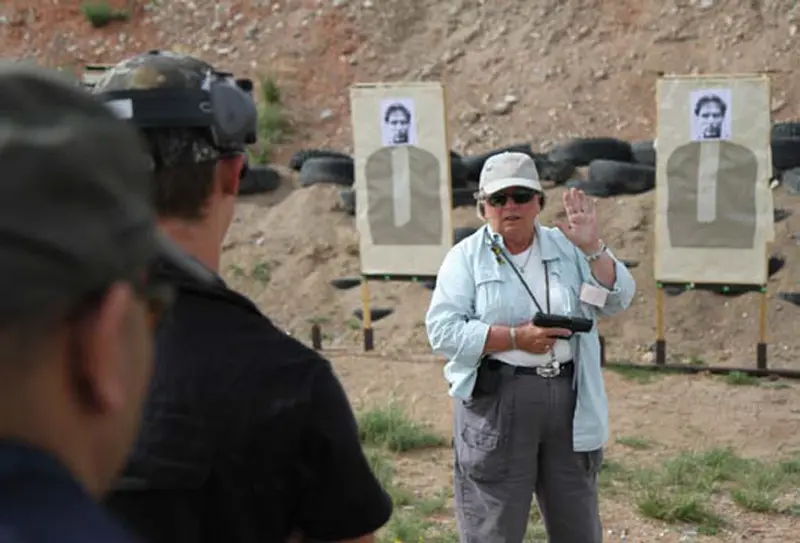
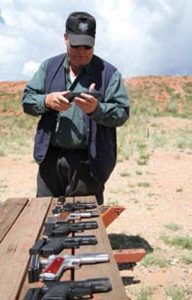
LOAD ‘EM AND MOVE
The first thing students were required to do on the range was load their weapons, and they remained loaded for the rest of the course. Farnam explained that he never trusts an unloaded weapon. This direction was carried out to the extreme: if a student ran dry, ammunition was found before the student could leave the line.
In a DTI course, the only time you do not move is when you are actually shooting. Drawing a weapon is done on the move. Reloads are done on the move. Stoppage drills are done on the move. Shoot, move, evaluate, repeat as necessary.
Farnam wanted students to learn to move off the X and explained that people get shot in the gaps. The gaps between shooting, that is. Farnam quipped, “Shoot Chicago style: shoot early, shoot often.”
Turning around while holding a loaded weapon is radical in firearms training. As part of the near-continuous movement, the student moved with his loaded weapons in Position SUL (“south” in Portuguese). Only after this 360-degree movement was the student ready to reholster or sling. “Is it dangerous?” John heartily replied, “Sure. But what isn’t?” Farnam trains his students to function in the real world, and his training technique clearly reinforces his goals.
A typical silhouette target opened the shooting portion of the course, but a target with a four-inch-wide strip of tape down the middle from the navel to the Adam’s apple. John’s instructions were to fire four rounds and hit the strip starting at the bottom and working up incrementally one round at a time. Farnam calls this the Zipper Technique. He noted that shooters are generally asked to hit the target, and some hit the silhouette and some miss, but when asked to hit the strip, the misses still hit the silhouette.
If there is one thing that DTI pings on, it is “catching the link.” Every weapon system has that point where the trigger resets. Farnam wants the shooter to begin another trigger pull at that instant. Allowing the finger to bounce off the trigger can otherwise upset the shooting cycle, and in any case it takes unnecessary time.
NO ENDORSEMENT ZONE?
Farnam does not endorse products, but it is clear that he has strong preferences, as evidenced by what he uses and carries. Farnam exclusively uses the Rotator and Urban Rifle steel targets by Safe Direction.
The Rotator is a deceptively simple vertical spinner. Two 8”x8” steel paddles, one to each side of center, rotate as they are struck. As the paddles turn, the relative size changes, and as the rotation speed increases, the window of opportunity to shoot decreases. With enough momentum, the paddles will spin complete circles.
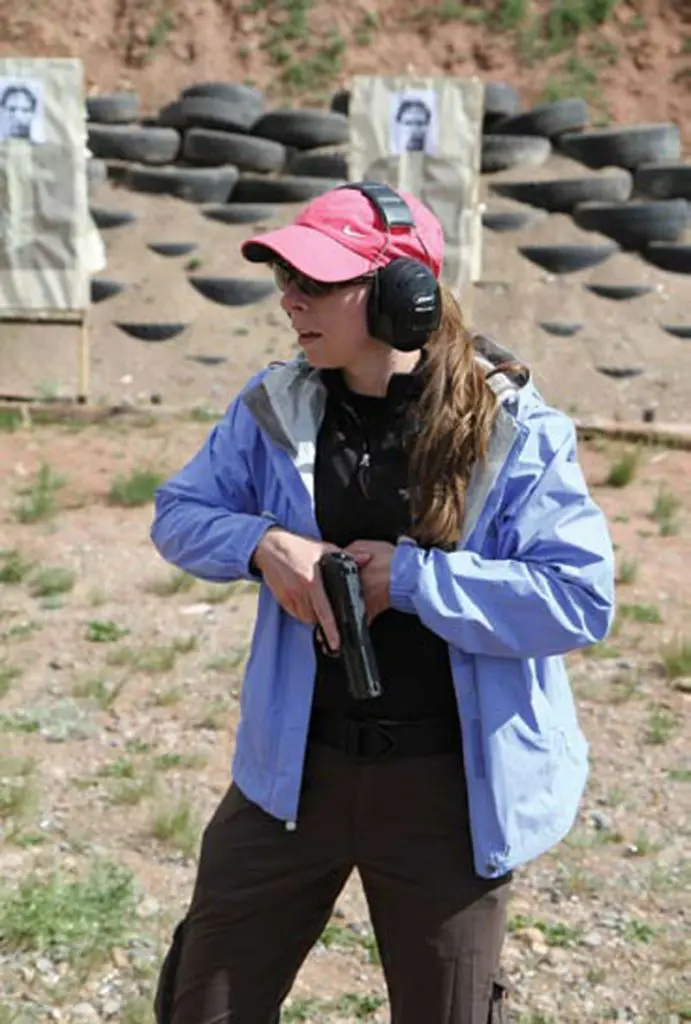
A line of Urban Rifle targets was used on all rifle drills except for sighting in and hostage rescue drills. The 8”x12” impact area of ½ AR500 steel was sufficient to handle the high volume of rifles fired at them.
Farnam also personally carries the Pistol Transport Case Ballistic Containment System from Safe Direction. This simple case has a Kevlar pad so that a pistol can be handled, pointed at the case and contain the projectile in the event of a negligent discharge. John demonstrated the ballistic case by shooting two .40 S&W rounds into it at point-blank range. The case was damaged, but the bullets were contained.
DRILLS
As I noted earlier, Farnam prefers a utility gun and preaches that “a warrior should not have a favorite weapon.” Farnam therefore conducted a Battlefield Pick-Up drill for each type of weapon brought to the class—a handgun not of the type or caliber that you carry, a rifle of different barrel length and optics, etc. Farnam used the exercise to demonstrate that firearms are more alike than they are different. It was also interesting for students to fire different types of weapons used by their fellow students.
One remarkable rifle drill was the High Volume Round exercise. From 40 meters, students were required to fire 100 rounds as quickly as they could. Two shots, move, two shots, move, reload as required. Several goals were demonstrated. One was the zero of the rifle. The group of shots clearly indicated whether the rifle was in fact sighted in. To a small degree, the High Volume Round exercise tested equipment. Farnam stated, “We hope everything breaks in a situation that does not cost you your life.” In addition, the drill gave each student confidence that their rifle was up to the challenge.
Farnam emphasized hostage rescue using both handgun and rifle. The intention of the Hostage Rescue drill was to induce “flaccid paralysis,” which is the instant de-animation of a hostage taker. With both handgun and rifle, the target is the tip of the nose. A bullet passing through this area of the head causes the desired results.
With an AR-type rifle set to Maximum Point-Blank Range (MPBR), the initial and secondary intersections of line of sight (LOS) and point of impact (POI) will occur at 40 meters and 240 meters. The bullet will start out 2.5” low and cross LOS and POI at 40 meters. The bullet’s path will be 2.5” high at 150 meters, the maximum ordinate, and then LOS and POI cross again at 240 meters. The shooter must therefore be aware that at close range, the rifle must be aimed 2.5 inches high.
Although Farnam’s training has nothing to do with competitive sporting events, he uses individual competitions to demonstrate and reinforce his training concepts. During the rifle portion of the class, students were instructed to hit the Urban Rifle targets five times, starting from movement and requiring at least two movements while delivering the five shots, all in an appointed amount of time. This competition is only against the time, but is sufficient to make shooters work, think and plan.
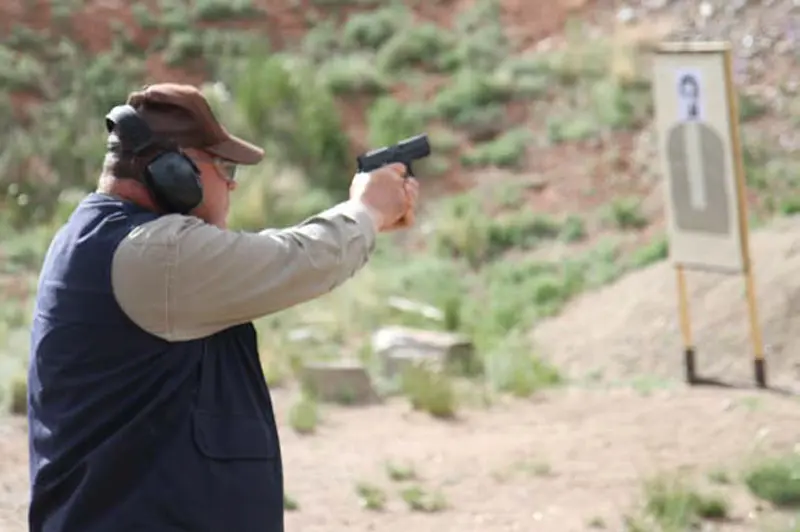
THE MAN WITH THE PLAN
You would think that an internationally recognized firearms instructor would be very serious and stuffy, but at times Farnam can be a stand-up comedian. Although he’s a live wire of solid practical information about defense, he also throws out one-liners as fast as his students can catch their breath. Entering the room, he asks if this is a “tactical cross-dressers” convention. Patching targets is labeled the Walk of Shame, as only misses are patched. Unexpectedly, Farnam turns his ball cap around and breaks into a rendition of “Reloader’s Rap,” a hilarious but pointedly accurate song about reloading and engagement.
Bonus entertainment aside, the bottom line is that the knowledge DTI passes along to its students can keep you and your loved ones safe and secure.
